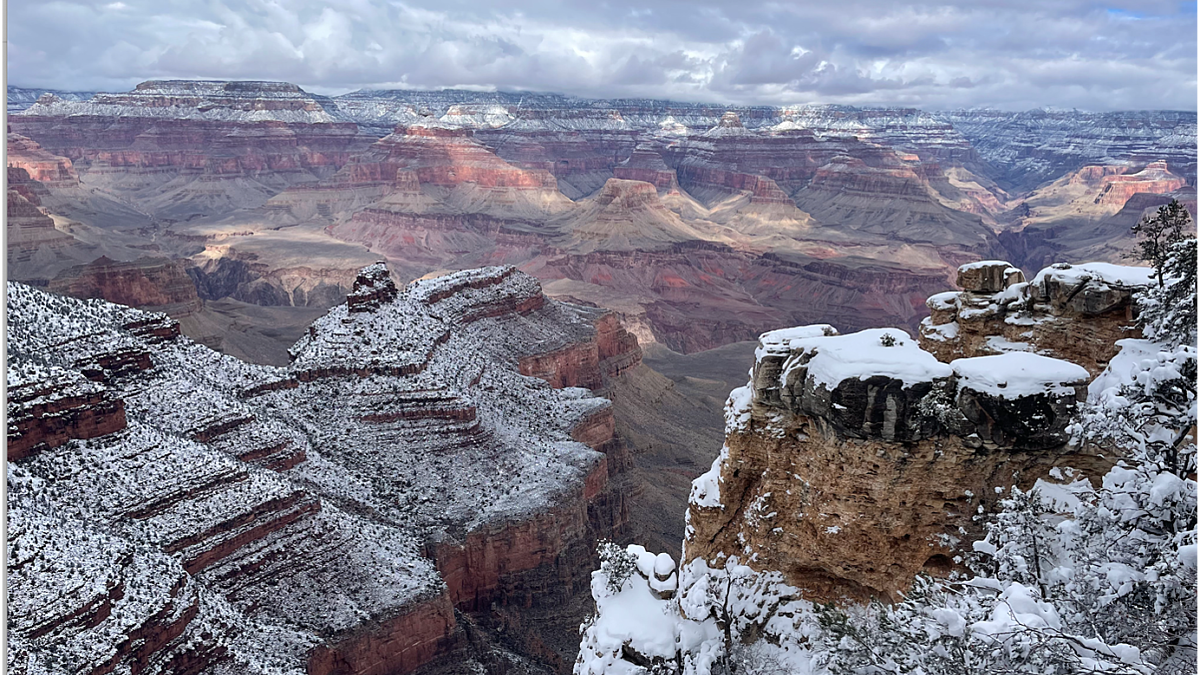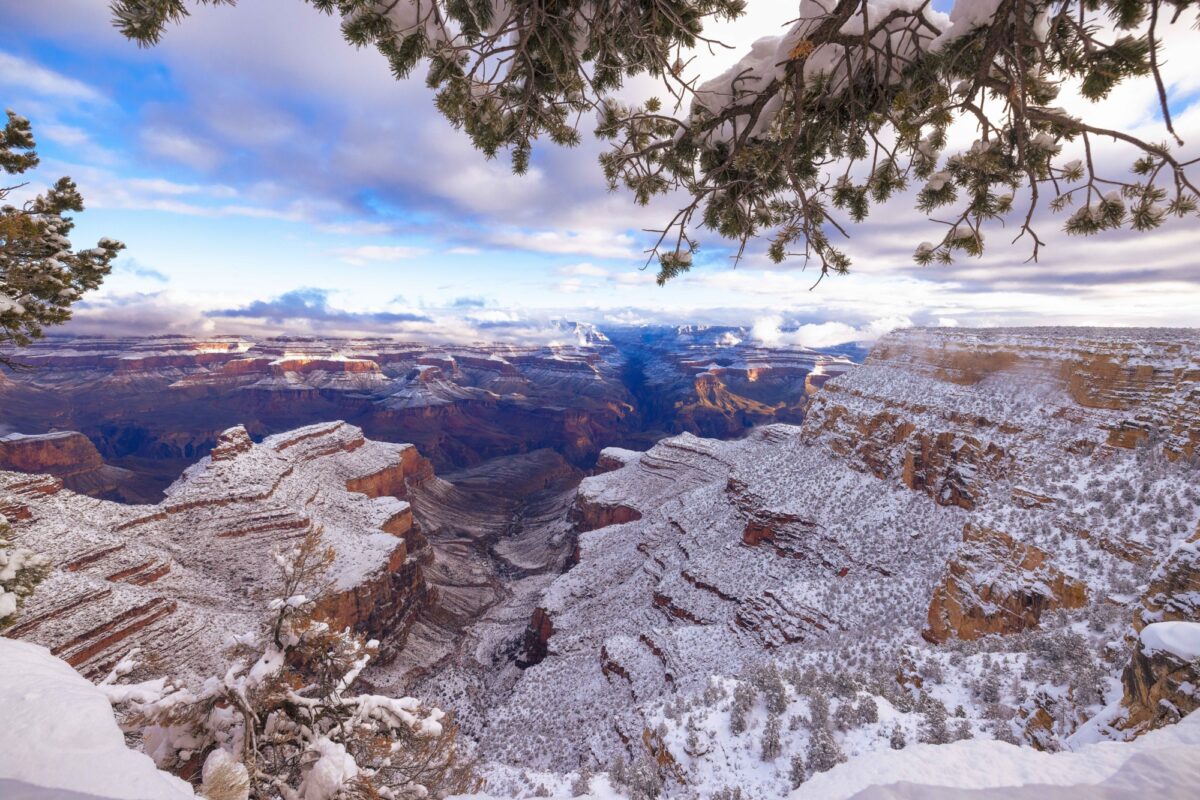Former GCC Astronomer in Residence on the Importance of Public Lands
In this blog series, former Grand Canyon Artists and Astronomers in Residence reflect on the important role America's public lands play in art and science.

The first night I gave a talk as the Grand Canyon’s Astronomer in Residence, it was a few days after a sudden but intense blizzard that left piles of snow on the rim trail and a bitter cold hanging in the air. It was also, I soon remembered, Super Bowl Sunday. Despite all that, the Visitor Center Theater slowly filled with people, bundled in hats, scarves, and thick jackets, ready to hear what I had to say about NASA’s plans to return to the ice giants. While it was a wonderful night chatting with an engaged audience about work that means the world (and beyond!) to me, what stuck with me since I’ve left the canyon is the first question I received. A park visitor politely but directly asked, "Why is any of this important? How does it help us here on Earth?"
I think it’s imperative to answer this question, and to keep answering it, because it applies to Grand Canyon and public lands as much as it does to outer space. But the framing of how we answer really matters. We can track the “usefulness” of space in the number of innovative technologies invented as part of the process, like GPS satellites, or in the number of breakthroughs scientists have about the universe. In much the same way, we can track the “usefulness” of Grand Canyon by the number of park visitors that pass through the front gates, attend public events, or make it down to buy a lemonade at Phantom Ranch.
However, reducing Grand Canyon to a series of metrics, of money spent and pictures taken, belies its true value for visitors and park workers alike. Amid times that feel increasingly unstable, it’s more important than ever for people to have the time and ability to look out at the canyon and wonder, and look up at the stars and hope.
Astronomers have argued that “access to a dark night sky – to see the universe as it really is – should be a human right.” Ongoing efforts to preserve dark skies, and extend their access to as many people as possible, are intertwined with the work to preserve public lands, and ensure their stewardship for future generations. At its most basic level, being able to see the Pleiades star cluster provides no more “use” to the average person than simply the knowledge that they’re there, just like how visiting Grand Canyon, Yellowstone, Acadia, or any other public lands only gives us exactly what we asked for, which is the opportunity to see something that others have deemed worth our time. Such a framing suggests that the experience of public lands begins and ends at the visit. We came, we saw, we bought a postcard. But that’s not at all what I’ve seen, regardless of whether it's walking visitors through the path of the Milky Way or the Trail of Time.

A visit to Grand Canyon begins once we see it spilled out before us, and it continues as the sight sparks joy and inquiry. Why do the rocks at the base of the canyon look so different from those at the top? What kind of fish swim in the river, which peeks out far below? How have the movements of the stars guided the lives of people who’ve lived here for hundreds of years? Once visitors have started asking these questions, and allowed the canyon to rearrange their thinking, their visit never really ends. They may go home and write, or make art, or study a new field of science, all because of what they’ve seen. Or they may go home and continue their lives as usual, buoyed by newly beloved memories. The true “value” of public lands is measured in individual journeys, which have outcomes that we’ll never know. What’s important, then, is that we fight for people’s right to take them.
I have a favorite spot along the South Rim. I won’t tell you where it is, because everyone should have the opportunity to find their own place to stand that captures what the canyon means to them. During my time as Astronomer in Residence, I’d go out to my spot for sunrise and sunset to watch the deep yellows, reds, and browns of the canyon walls get stained pink and purple by the Sun. Sometimes I’d be stopped by other early morning visitors, or take pictures to send to other scientists back home. The response, from visitors and friends alike, was the same: “I didn’t know the world could look like this”.
It’s impossible to distill the “use” of public lands into something easily digestible or quantifiable, but to me, this is the easiest, and shortest description: public lands allow all who visit to realize that the world is so much more than they’d ever dreamed. Their use can be found in every visitor who finds first their sense of wonder, then their curiosity. As a geologist-turned-astronomer, I met countless visitors who came to me with questions connecting the history of the Grand Canyon to the history of the stars. They had reconnected with their desire to learn and explore, and wanted to know how the universe had formed, how billions of years of time had brought us here to this spot – to look out at the canyon and realize they didn’t know the world could look like this. It’s an experience we all should get to have, rooted in the right to know and understand our world, from the Grand Canyon to the night sky, and it’s one worth fighting for.

About the Grand Canyon Conservancy Residency Program
Grand Canyon Conservancy’s residency program supports Grand Canyon National Park’s priorities of dark sky preservation and inclusive storytelling by welcoming artists, scholars, and scientists from throughout the world to explore and contribute to Grand Canyon’s historic and cultural legacy. Our artists and astronomers engage the public in meaningful ways, adding to the collective scholarship on the region, and celebrating the rich environmental, spiritual, and cultural impact Grand Canyon has on the world. Learn about upcoming Artists and Astronomers in Residence and more about the program.
Written by Dr. Adeene Denton, GCC Astronomer in Residence, 2024

